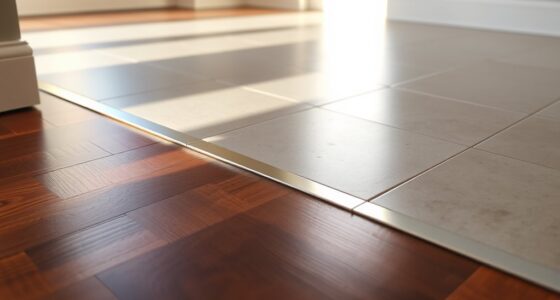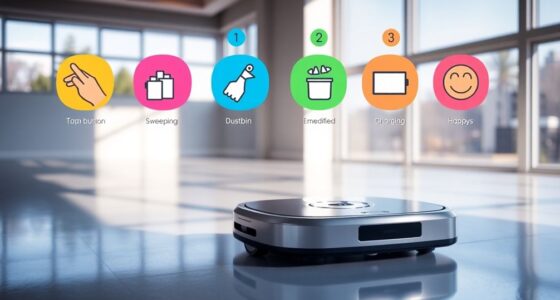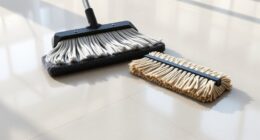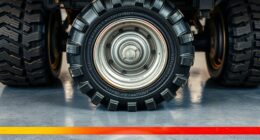On dark floors, manual cleaning is often better when you need precise spot treatment or deep stain removal, giving you full control and thoroughness. Robots are great for routine maintenance, using sensors to detect dirt and navigate awkward spaces efficiently. However, if you want detailed cleaning, manual tools excel on textured or stubborn stains. Keep exploring to discover how combining both can give you the best clean for your dark surfaces.
Key Takeaways
- Manual cleaning offers better control for targeting textured surfaces and stubborn stains on dark floors.
- Robots excel at systematic, routine cleaning and detecting dirt in low-visibility conditions.
- Manual methods are preferred for deep cleaning and removing dried or sticky spills.
- Robots are ideal for large areas and maintaining general cleanliness with minimal effort.
- Combining manual precision with robot efficiency ensures comprehensive cleaning on dark floors.

Cleaning dark floors can be challenging because their low visibility makes it harder to spot dirt and debris. When you’re trying to keep your floors spotless, you might find yourself squinting or bending down to see if you missed anything. This makes the process more time-consuming and frustrating. You need a method that can handle this visibility issue effectively. That’s where both manual and robotic cleaning options come into play. Understanding when each wins can help you choose the right approach for your space.
Manual cleaning, like using a traditional broom and mop, gives you direct control. You can focus on trouble spots or areas that seem dirtier without relying on sensors. This can be especially useful if your dark floors have textured surfaces or specific areas prone to spills. With manual tools, you see the dirt and dust directly, so you can target cleaning precisely. Plus, manual methods don’t depend on battery life or sensors, making them reliable for quick touch-ups or deep cleaning. If you’re dealing with a small area or want to ensure every corner is spotless, manual cleaning often wins because it offers thoroughness and control.
Manual cleaning offers direct control and precision, ideal for textured floors and targeted spot cleaning.
On the other hand, robotic vacuums excel in convenience and consistency. They are designed to navigate around furniture and under low-hanging objects, which can be tricky with manual cleaning. Modern robots use advanced sensors to detect dirt, debris, and obstacles, allowing them to clean systematically without missing spots. This is especially advantageous on dark floors, where dirt can be harder to see. Their sensors help them focus on areas that need more attention, making them efficient. If you have a large area or prefer a set-it-and-forget-it approach, robotic vacuums often win by saving you time and effort. They can operate regularly, maintaining cleanliness without much manual intervention.
However, there are times when manual cleaning wins over robots. For example, if your dark floors have sticky spills or stubborn stains, a manual mop or scrub brush often does a better job. Robots might struggle with these, especially if the stain is thick or dried. Similarly, if your space has cluttered corners or tight spaces, manual cleaning allows you to reach into those nooks more effectively. Robots are great for routine maintenance but may not handle deep cleaning or spot treatments as well as manual methods. So, if you need precision or tackle particularly tough messes, manual cleaning takes the lead.
Additionally, incorporating AI automation into your cleaning routine can significantly enhance efficiency by intelligently mapping and optimizing cleaning paths, reducing time and effort.
Frequently Asked Questions
How Do Dark Floors Affect Robot Navigation Accuracy?
Dark floors can substantially impact your robot’s navigation accuracy. Without sufficient lighting, sensors like cameras and lidar struggle to detect obstacles and boundaries, causing potential errors. You might notice the robot misjudging distances or missing objects, leading to inefficient cleaning or navigation failures. To improve performance, consider adding lighting, upgrading sensors, or using robots designed specifically for dark environments, ensuring they can operate effectively regardless of lighting conditions.
Are Manual Cleaning Methods Safer on Uneven Dark Surfaces?
Certainly, manual methods tend to be safer on uneven dark surfaces. You maintain better control, ensuring thorough cleaning without risking slips or slips caused by challenging terrain. Your hands-on approach allows you to navigate tricky spots carefully, avoiding potential mishaps that robots might miss due to limited sensors or poor lighting. So, if safety’s your priority, stick with manual cleaning on those uneven, dark floors.
What Maintenance Do Robots Require on Dark, Sticky Floors?
You need to regularly check and clean the robot’s brushes and sensors to keep it running smoothly on dark, sticky floors. Make sure the wheels are free of debris and that the vacuum’s filters are clean to maintain suction. You might also need to calibrate the sensors periodically to prevent navigation issues. Keep a close eye on battery health and perform software updates to optimize performance on challenging surfaces.
Can Robots Detect Hazards Differently Than Humans on Dark Floors?
Yes, robots can detect hazards differently than humans on dark floors. They use sensors like infrared, ultrasonic, and lidar to identify obstacles, spills, or uneven surfaces even in low-light conditions. These sensors process data quickly, allowing robots to spot hazards that might go unnoticed by the human eye. However, humans rely on sight and experience, which can sometimes be more adaptable. Combining both methods guarantees safer navigation on dark, sticky floors.
How Do Lighting Conditions Impact Manual Cleaning Effectiveness?
Lighting conditions greatly impact your manual cleaning effectiveness. In poor lighting, you might struggle to see dirt, stains, or hazards clearly, making thorough cleaning difficult. Insufficient illumination can cause missed spots and increase the risk of accidents. To improve results, make certain of adequate lighting, use powerful flashlights or headlamps, and take your time to inspect hard-to-see areas. Good lighting boosts your confidence and helps you clean more efficiently and safely.
Conclusion
So, next time you’re choosing between a robot or manual cleaning on dark floors, consider what matters most—speed, thoroughness, or control. Will you rely on technology to handle the job quietly and efficiently, or trust your own hands to guarantee every corner is spotless? Ultimately, it’s about what fits your needs best. After all, isn’t the goal to have a spotless home without the hassle, no matter which method you choose?









